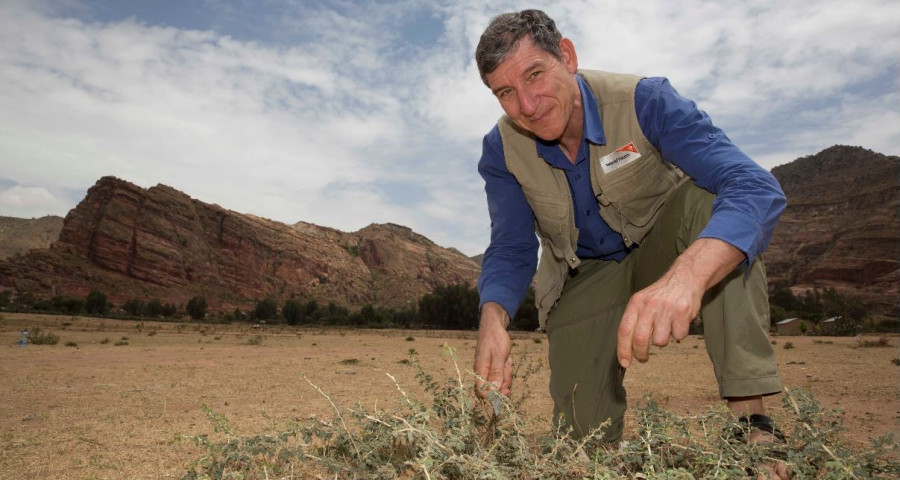Tony Rinaudo is an Aussie missionary, also known as 'the forest maker,' who is a Right Livelihood Award Laureate and Member of the Order of Australia. As a young man growing up in Victoria’s Ovens Valley, Tony formed a deep concern for trees and forests as he witnessed land degradation right on his doorstep.
In the hills and valleys of northeast Victoria, Tony was disturbed by the bulldozing of forests to make way for pine plantations and the contamination of mountain streams and fertile soils with toxic pesticides used to grow tobacco crops. Biodiversity was being lost and the environment abused in the name of “progress.” But how could this be progress, Tony wondered, when we focus on growing tobacco while children in other countries are going to bed hungry?
Shaped by these two desires to repair the environment and relieve poverty, Tony trained in agriculture at The University of Armidale where he met and married Liz, who shared his passion and the call to serve overseas. Step by step, God was guiding and providing, and in 1981 the recently married couple arrived in Niger, Africa.
 |
|
|
Ovens River Valley, where Tony grew up. Photo: Russell E. |
What Tony saw when he arrived in 1981 were large swathes of “moonscape.” Trees were incessantly cut down to grow their main food crop – millet. Poor and often hungry farmers saw trees on their land as weeds to be eliminated. The result was rampant deforestation. This desert moonscape was an ecological and a livelihood disaster, as the land could no longer provide for the people living on it. Tree removal was not nurturing growth and health, but facilitating desertification, famine, poverty and drought – a destructive cycle.
For the first few dogged years, Tony tried conventional tree-planting, but to his deep frustration, the new trees were dying because of neglect, animals, drought, sandstorms, or termites. Adding to a sense of failure was the indifference and even hostility of many locals to the idea of reforestation – the farmers called him “the mad white farmer.”
He recalls the day that he angrily prayed, “Lord, why did you bring me out here? You could have just as easily made a fool of me in Australia. You didn’t have to bring me all this way.” Yet, in desperation, he also asked of God, “Open our eyes; show us what to do. Help us.”
After two-and-a-half long years of frustration and failure, Tony experienced his “lightbulb” moment:
He says: “In the past, I had always hurried to get on with the job of tree-planting. But not today … A ‘bush’ on the side of the road caught my attention. Thinking the bushes scattered across the landscape were just desert shrubs or weeds, I never gave them a second thought. I walked over and took a closer look … This was not a ‘bush’. These leaves belonged to a tree. It had been cut down, and they were resprouting from the stump! These ‘bushes’ were living time capsules ready to recolonise the land if given a chance. I realised that I was standing on an underground forest.”
Even in the some of the harshest desert landscapes, the shoots of the underground forest can be encouraged to grow into trees by pruning and management. Tony had discovered an embarrassingly simple method of restoring landscape without planting a single tree!
It took two-and-a-half years to see a solution. Attitudes changed slowly at first, but over the following 20 years adoption of this method of tree restoration went viral. There was hostility, derision, and joking about Tony’s method, and an ingrained rejection of anything out of the ordinary, anything not traditional. But through the catastrophic drought of 1984, Tony’s “food-for-work” program was catalysed, leading to a gradual acceptance of the method which went on to spread from farmer to farmer.
 |
 |
|
Satellite photos taken in 1975 (left) and 2005 (right) show greatly increased tree cover in southern Niger. Trees are shown as black dots. Source: US Geological Survey. |
Tony’s pioneering method is called FMNR, Farmer-Managed Natural Regeneration. FMNR is simple, sustainable, and low cost. This is great news, as the benefits of FMNR are seemingly endless:
- It helps create more diversified and resilient farming systems, reducing the likelihood of famine.
- It increases essential biodiversity, increases soil moisture holding capacity and significantly reduces soil and air temperatures.
- When applied at scale, it has the potential to draw down millions of tonnes of carbon dioxide from the air, providing a nature-based solution to climate change.
- And it feeds people! In Niger alone, local farmers embracing FMNR have rehabilitated more than five million hectares of degraded land (that’s over 200 million trees!) while doubling their crop yields and income. Tony says, “In Niger, our calculations show that, because of FMNR the additional food grown can feed an extra 2.5 million people every year.”
It’s almost too good to be true. The news is out: according to Chris Reij at the World Resources Institute, “FMNR is probably the largest positive environmental transformation in the Sahel and, perhaps, in all of Africa.”
 |
|
“There’s nothing new about [FMNR]. It’s a traditional method of coppicing that has existed for centuries,” - Tony Rinaudo. Photo: Tony Rinaudo/World Vision Australia.
|
Now as World Vision Australia’s Principal Climate Action Advisor, Tony has a mission is to see FMNR introduced into 100 countries by 2030. He wants to initiate a global FMNR movement that will result in the restoration of, not millions, but one billion hectares of land. Restoration at such a scale will have a huge positive impact on communities, climate, and the environment. FMNR has already been introduced into 27 countries and continues to spread.
“It’s such a simple solution to so many environmental and humanitarian issues. I hope Australia can become a global leader in supporting and investing in this technique,” Tony says.
The story of this Aussie from the bush is exciting news, offering incredible hope for our planet right at the time when the latest IPCC report (2022) conveys worrying climate trends. It’s no wonder the recent UN’s COP26 in Glasgow stresses how vital it is for all of us to work together for this beautiful world.
 |
|
How can we play a part in this great news? We can tell the story. Tony’s powerful testimony carries a mighty message of hope. It’s worth telling, worth spreading, and worth being a part of. Tony has written his inspiring story in his new autobiography The Forest Underground: Hope for a Planet in Crisis, with proceeds going to the global FMNR movement. It will be published by ISCAST (The Institute for the Study of Christianity in an Age of Science and Technology) on April 30th. You can support FMNR by pre-ordering the book from ISCAST or Amazon, and through the FMNR hub here. Will you join the journey and be a part of healing the planet?
This story first appeared in the November 2021 edition of Eternity magazine and has been edited for publication here. David Hooker is Publications Director for ISCAST–Christians in Science and Technology. He is trained in science and theology and recently completed doctoral studies synthesising science and theology. More details about Tony’s book are available on the ISCAST website.


